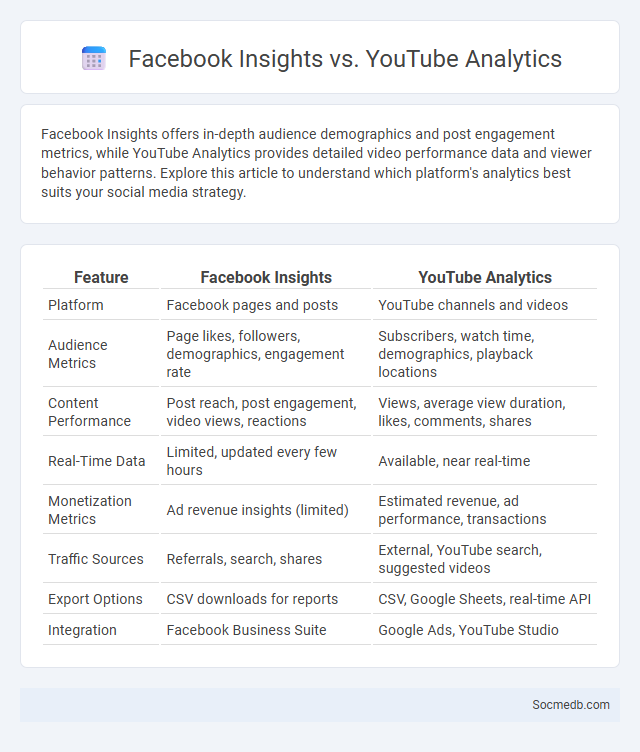
Photo illustration: Facebook Insights vs YouTube Analytics
Facebook Insights offers in-depth audience demographics and post engagement metrics, while YouTube Analytics provides detailed video performance data and viewer behavior patterns. Explore this article to understand which platform's analytics best suits your social media strategy.
Table of Comparison
| Feature | Facebook Insights | YouTube Analytics |
|---|---|---|
| Platform | Facebook pages and posts | YouTube channels and videos |
| Audience Metrics | Page likes, followers, demographics, engagement rate | Subscribers, watch time, demographics, playback locations |
| Content Performance | Post reach, post engagement, video views, reactions | Views, average view duration, likes, comments, shares |
| Real-Time Data | Limited, updated every few hours | Available, near real-time |
| Monetization Metrics | Ad revenue insights (limited) | Estimated revenue, ad performance, transactions |
| Traffic Sources | Referrals, search, shares | External, YouTube search, suggested videos |
| Export Options | CSV downloads for reports | CSV, Google Sheets, real-time API |
| Integration | Facebook Business Suite | Google Ads, YouTube Studio |
Overview of Facebook Insights, YouTube Analytics, and Instagram Insights
Facebook Insights offers comprehensive data on user engagement, reach, and demographics, enabling you to track the performance of your posts and page activity. YouTube Analytics provides detailed metrics such as watch time, traffic sources, and audience retention, essential for optimizing video content and increasing viewer retention. Instagram Insights delivers valuable information on follower activity, impressions, and content interaction, helping you tailor your posts to maximize engagement and growth.
Key Metrics Tracked: Comparing Platforms
Key metrics tracked across social media platforms include engagement rate, reach, impressions, and click-through rate, with Instagram excelling in visual engagement and Twitter dominating real-time interactions. Facebook's advanced targeting capabilities provide valuable insights into audience demographics, while LinkedIn metrics emphasize professional networking and lead generation. Understanding these platform-specific performance indicators helps you optimize content strategy and measure success effectively.
Audience Demographics and Reach Analysis
Understanding audience demographics is crucial for targeted social media marketing, as it reveals the age, gender, location, and interests of your followers. Reach analysis measures how many unique users have seen your content, helping you evaluate the effectiveness of your social media campaigns. By combining these insights, you can tailor your strategy to maximize engagement and expand Your online presence efficiently.
Engagement Metrics Breakdown
Engagement metrics on social media include likes, comments, shares, and click-through rates, providing detailed insights into how users interact with your content. Tracking these metrics helps optimize content strategies by identifying what resonates most with your audience and drives meaningful interactions. Your ability to analyze engagement data directly impacts the effectiveness of your social media campaigns and overall brand growth.
Content Performance Measurement
Content performance measurement on social media involves analyzing metrics such as engagement rate, reach, impressions, and click-through rates to gauge the effectiveness of posts. Utilizing analytics tools like Facebook Insights, Instagram Analytics, and Twitter Analytics helps in tracking audience behavior and content trends. Optimizing strategies based on data-driven insights enhances content relevance, boosts visibility, and drives higher user interaction.
Video Analytics: Facebook vs YouTube
Video analytics on Facebook and YouTube provide crucial insights into viewer behavior and content performance, with Facebook offering in-depth data on audience demographics, engagement rates, and real-time video interactions. YouTube's robust analytics platform highlights watch time, traffic sources, and user retention metrics, enabling precise optimization of video content for better reach and monetization. Understanding these platforms' analytics tools empowers you to tailor your video strategy to maximize audience engagement and growth effectively.
Reporting and Data Export Features
Social media platforms provide advanced reporting and data export features that enable businesses to analyze user engagement, track campaign performance, and measure audience growth effectively. These tools often include customizable dashboards, detailed metrics such as reach, impressions, click-through rates, and demographic insights, which can be exported in formats like CSV or Excel for deeper analysis. Leveraging these capabilities helps marketers optimize strategies, improve ROI, and make data-driven decisions for targeted social media campaigns.
Real-Time vs Historical Data
Real-time data on social media platforms enables immediate analysis of user interactions, trending topics, and engagement metrics, essential for timely decision-making and marketing strategies. Historical data provides comprehensive insights into long-term user behavior, campaign performance, and content trends, allowing for in-depth analytics and predictive modeling. Leveraging both real-time and historical data enhances social media management by balancing instant responsiveness with strategic planning.
Integration with Third-Party Tools
Effective social media platforms offer seamless integration with third-party tools such as analytics software, marketing automation, and customer relationship management (CRM) systems to enhance your campaign performance. These integrations streamline data flow and provide comprehensive insights into audience behavior, enabling more targeted content creation and strategic decision-making. Leveraging such connected tools maximizes engagement and ROI on your social media efforts.
Choosing the Right Analytics Tool for Your Needs
Selecting the right social media analytics tool depends on your specific goals, whether it's tracking engagement, measuring ROI, or monitoring brand sentiment. Tools like Hootsuite and Sprout Social offer comprehensive dashboards for real-time data, while platforms like Google Analytics provide deeper insights into conversion tracking from social traffic. Evaluating features such as data accuracy, integration capabilities, and user interface ensures you choose an analytics solution tailored to your marketing needs and budget.
 socmedb.com
socmedb.com